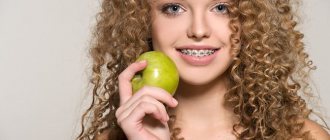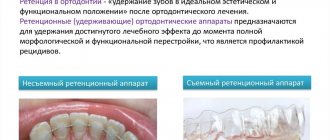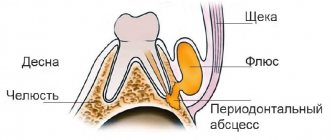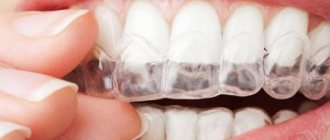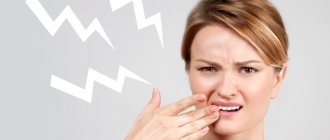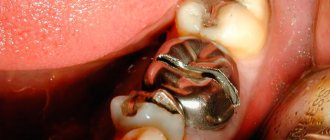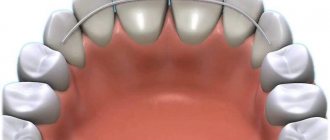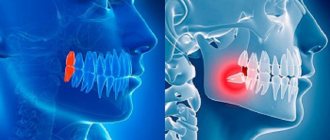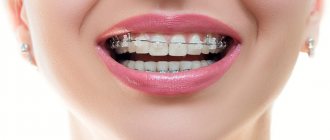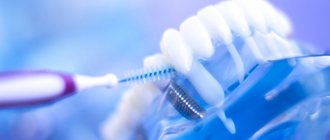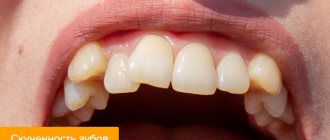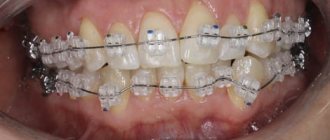Sometimes, after installing braces, a person notices that his teeth have become too mobile. Many people begin to panic and go to the dentist to remove the orthodontic appliance. But in most cases, tooth mobility is normal. In this article we will tell you why teeth become loose after braces and what needs to be done.
In this article
- Changes in the mouth while wearing braces
- Why are teeth loose?
- Why do teeth wobble under braces from an anatomical point of view?
- What to do if teeth become loose under braces?
- Why do you need retainers for loose teeth?
- In what cases is loose teeth not normal?
- Proper care will protect against loose teeth
Changes in the mouth while wearing braces
Installing a brace system to correct a bite or straighten teeth is almost always accompanied by an adaptation period. In some patients it can be several days, in others - a couple of weeks, it depends on the individual characteristics of the body. During the adaptation period, elements of the orthodontic structure can rub the mucous membrane, lead to the formation of ulcers on the inside of the lips and cheeks, and cause discomfort. Patients are warned about possible temporary disturbances in diction and difficulties in pronouncing certain sounds.
But practice shows that many are not prepared for the loosening of their teeth while wearing braces. If a tooth is loose under braces, there is a fear of losing it. Is it really possible to lose loose teeth on which braces are attached? In most cases, unusual mobility is normal and, as long as your dentist recommends it, will not lead to tooth loss.
Mobility of the bracket system
If you do not maintain proper hygiene while wearing braces, the structure may begin to wobble. This can be caused by deformation of the archwire, unsticking or displacement of the bracket. The cause may also be a loose ring that secures the structure.
If there is any damage to the alignment structure, it is important to contact an orthodontist. If a visit to the clinic for some reason cannot be carried out in the near future, the element that has lost its fastening strength should be secured with orthodontic wax. But you shouldn’t put off visiting the doctor too much. In the absence of structural elements or their poor-quality fastening, load redistribution occurs, which can cause serious adverse consequences.
Why are teeth loose?
To understand the reason why a tooth is loose, you need to know how the braces system works and how it works. The design of the bracket system is such that a small lock is attached to each tooth according to a certain pattern. An orthodontic arch made of shape memory material is installed in the fastenings of each lock. This arch puts pressure on the dentition and promotes tooth movement.
What causes the displacement? Under the influence of a directed load, the bone tissue on one side decreases, the tooth socket expands, which allows the tooth to move to a new location. At the same time, in order for him to sit firmly in a new place, on the other hand, the bone tissue must grow, this process takes time. During the period when the socket has already widened, and not enough new bone tissue has grown, the teeth can be mobile. That is, their mobility during the period of movement is the norm, which should not frighten. The main thing is to fix the tooth in its new place in the jawbone after displacement.
Folk remedies to prevent loosening
The right thing to do if you notice problems with your braces is to visit an orthodontist. But, if there is a lot of time left before the visit, you can help yourself with some folk remedies. Various herbs and home remedies are used for this, but toothpaste is the best one.
You should squeeze the paste onto your toothbrush as if you were brushing your teeth normally and drop some essential oil on it (one drop will be enough). It is a natural antiseptic that is often used to protect gums from inflammation. You should brush your teeth with this solution at least twice a day.
Let's look at other folk tricks:
- Licorice root reduces plaque formation on teeth;
- Massaging the gums using turmeric, black pepper and alum helps a lot;
- Blueberry roots and hawthorn berries significantly strengthen teeth.
Why do teeth wobble under braces from an anatomical point of view?
Teeth are made up of two main parts—the dental crown (the visible part) and the root. They are connected to each other by a ligament supported by bone tissue. Under the pressure of braces, the tooth tilts, as a result of which the distance between the ligament and the dental crown changes: on the one hand it becomes larger, and on the other, on the contrary, smaller. Special cells - osteoblasts - begin to actively work and restore the missing bone tissue to create a new support for the tooth. Other cells—osteoclasts—perform the opposite job: they promote the resorption of bone tissue where the tooth needs to be moved.
In this way, the pinched connective ligament gradually straightens out, and the tooth can take its correct position. Such cycles of loss and growth of bone tissue are repeated many times during orthodontic correction, contributing to the gradual correction of the dentition.
But the speed of these processes is different: bone tissue is absorbed faster than it grows. This is the main reason why teeth become loose after braces start working.
Reviews
Orthodontic treatment is a long and serious process, on which not only the beauty of the dentition, but also its health depends.
Therefore, problems may arise, and it is best to pay due attention to their solution by immediately contacting a doctor. However, in most cases, mobility and unsteadiness are normal.
In the comments to this article, you can share your experience or leave feedback.
If you find an error, please select a piece of text and press Ctrl+Enter.
Tags: braces vestibular braces
Did you like the article? stay tuned
No comments yet
What to do if teeth become loose under braces?
First of all, you need to contact an orthodontist and make sure that the loosening process is physiological and does not threaten the teeth. If the doctor confirms that everything is in order, then you just need to follow the dentist’s recommendations. In particular, reduce the load on the teeth:
- temporarily avoid solid foods (carrots, apples, nuts, caramels, seeds);
- exclude chewing gum, toffees, corn flakes, dried fruits and other foods that stick to the teeth;
- do not bite nails or pencils;
- follow a “soft” diet, which includes mainly liquid and puree dishes (porridge, pates, smoothies, vegetable and fruit purees).
Following these recommendations will not only prevent the loss of mobile teeth, but will also protect the braces from damage. For accelerated bone tissue regeneration, it is important that the diet contains protein products and a full range of essential minerals and vitamins.
Tooth loss during and after braces
If your teeth are loose, braces are not recommended. You must first determine the causes of this symptom and get rid of them. Braces can only be placed on a healthy jaw.
Sometimes it happens that teeth fall out after braces. This problem is faced by patients who had jaw pathologies before the installation of corrective plates. In this case, the dentist chooses the further treatment method. It is necessary to first establish and eliminate the cause of the loss, restore the evenness of the row and perform prosthetics.
Why do you need retainers for loose teeth?
After removing the braces, in most cases it is necessary to wear a special orthodontic mouthguard, or retainer. Its main function is to fix and hold the teeth in the correct position until the process of regeneration of new bone tissue is completely completed. If you neglect to wear a retainer, your teeth may return to their original place after the braces are removed.
The retention period when it is necessary to wear a mouth guard lasts approximately 2 times longer than the period of wearing braces. On average it is 3-4 years. During this time, the process of bone tissue restoration should be completely completed, the teeth will completely stop loosening and will remain securely in their new place.
Adjuvant therapy
The main treatment involves auxiliary therapy aimed at preventing further loosening of the teeth. It includes:
- prescription of anti-inflammatory drugs, vitamins, biostimulants;
- ointments, gels to strengthen gums;
- antibiotic therapy;
- systematic professional teeth cleaning;
- physiotherapy (electrophoresis, plasma lifting, etc.);
- gum massage
If the front tooth becomes loose after an impact or several lower units become mobile due to bleeding gums, treatment should begin as quickly as possible. Complex therapy in the early stages around the moving element will help to form healthy tissue, ensuring reliable retention of the tooth in the gum. In complex, advanced cases, with 4 degrees of mobility, removal followed by prosthetics is advisable.
In what cases is loose teeth not normal?
Rarely, there are situations when the cause of tooth loosening is not in the physiological process of resorption and growth of bone tissue, but in some kind of disease.
For example, teeth may become loose if a patient develops osteomyelitis or osteoporosis. Also a common cause of pathological loosening is periodontal disease in the acute stage. Teeth become mobile due to gingivitis, periodontal disease, and periodontitis.
And if bone pathologies arise on their own, then periodontal diseases are most often caused by insufficient hygienic oral care and braces.
In any case, to exclude pathology of the bones or gums, at the first sign of loose teeth, you should consult a dentist. The doctor will conduct a full diagnosis, determine why the teeth are loose and, depending on the results of the examination, prescribe treatment or give recommendations.
Causes of loosening
Braces systems are used to correct anatomical defects of the jaw. The base is installed on each tooth, after which it is fixed with arches. It is assumed that under the influence of this design the row will shift in a given direction.
The cause of loosening when wearing an orthodontic structure may be a physiological reaction or a pathological process. You will not be able to determine on your own what caused the problem. You should definitely see a dentist and get individual recommendations.
When it's ok
Teeth are considered the most functional skeletal system in the human body. Therefore, dentists can easily adjust their position and correct anatomical defects. While wearing the corrective system, the incisors and canines naturally become loose. This process is caused by the interaction of osteoclasts and osteoblasts.
- The base of the bracket is securely attached to the enamel. Each unit is fixed to each other using a metal arc. Under the influence of tension and pressure, a gradual displacement of the incorrectly positioned tooth occurs.
- When displaced, the space between the root and the jaw bone increases. Because of this, the patient may notice slight loosening. Over time, young bone tissue cells are formed in this zone, synthesizing the intercellular matrix - osteoblasts. The resulting empty space is filled with new structures.
- The shifting root requires new space to change position. If on one side it appears and is filled with a new matrix, then on the other it should disappear. This process is supported by osteoclasts - giant multinucleated cells that destroy excess layers of bone tissue.
Important!
The balance of osteoblasts and osteoclasts is controlled by the human body. Most often, the resorption of bone tissue occurs quickly, and the growth of new tissue occurs slowly. Therefore, for a long time, the incisors and canines become loose after the braces are removed. To correct this consequence, retainers are used.
When to worry
It cannot be stated unequivocally that teeth cannot fall out due to braces. Sometimes pathological processes lead to the loss of incisors and canines (less commonly, premolars and molars). Therefore, you should always worry about loosening, but not in all cases the alarm will be justified.
The cause of complaints may be pathological processes. These include periodontitis, gingivitis, periodontal disease. Signs that the patient has problems:
- increased bleeding of gums;
- reduction of gingival papillae;
- root exposure;
- painful sensations when biting and chewing food;
- swelling and redness of the gums;
- itching;
- increased body temperature;
- headache;
- suppuration of the gum pocket.
Proper care will protect against loose teeth
One of the causes of loose teeth is periodontal tissue disease. To prevent their development, you need to properly care for your mouth while wearing an orthodontic appliance.
Proper care involves daily brushing of teeth with 3-4 types of brushes - regular, special orthodontic with a V-shaped bristle, single-tuft and brush-brush. These devices are used alternately, gradually removing all dirt and plaque. After brushing your teeth, you need to clean the interdental spaces using superfloss - a special orthodontic dental floss. At the final stage, the oral cavity and the braces system are cleaned using an irrigator. This device directs a powerful stream of water, which removes dirt from interdental spaces, periodontal pockets and other difficult areas. To care for braces, it is important to purchase irrigators with special orthodontic attachments.
Careful and regular oral care will prevent pathological loosening of teeth under braces and avoid their loss.
Alarm bells
It is not always normal for teeth to become loose when correcting a bite. There are situations when a patient, in parallel with treatment, develops an inflammatory process in the hard or soft tissues of the oral cavity.
In order not to miss the onset of the disease, dentists recommend paying attention to the appearance of the following signs:
- redness, swelling and bleeding of the gums;
- carious lesions on the surface of molars;
- formation of erosions and ulcers on the mucous membrane;
- pathological abrasion of enamel;
- severe pain in certain areas of the jaw arch;
- the appearance of purulent discharge.
The listed signs may indicate the development of serious diseases of the teeth and gums in a person - gingivitis, periodontal disease, osteomyelitis, bruxism, osteoporosis.
These conditions require urgent treatment, since, gradually progressing, they can lead to the destruction or loss of teeth, the development of purulent-necrotic processes and fractures of the jaw bones.
Dentists note that the development of pathological conditions that cause loosening of teeth can occur for various reasons. Most often this happens due to poor oral hygiene, non-compliance with the rules of wearing braces, or injury to the jaw.
Problems after committing
The structure of the dentition is characterized by the connection of teeth and bone tissue with the help of ligaments surrounded by a dense structure that maintain a stable position. The pressure exerted by braces reduces the density of fixation. At the same time, natural factors that arise after the installation of an orthodontic apparatus include:
- Slightly expressed mobility of units;
- The problem appears in the first days after fixation.
Preservation of the natural state of the gum tissue (without inflammatory processes and acute pain) indicates the normal development of events. If there are uncharacteristic symptoms, as well as doubts about the physiological correspondence of the changes that occur, it is recommended to undergo a comprehensive examination to identify anomalies and pathologies.
